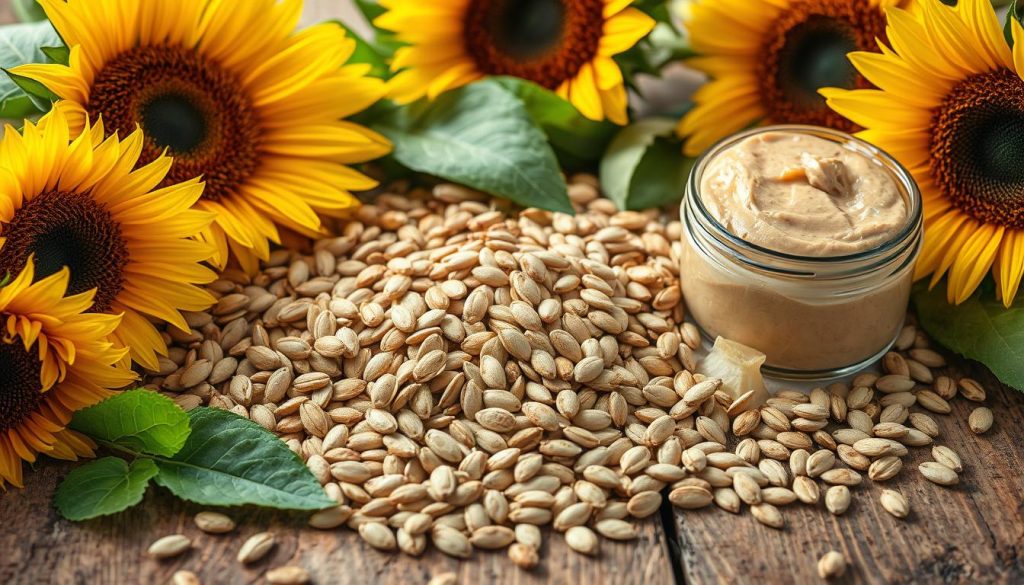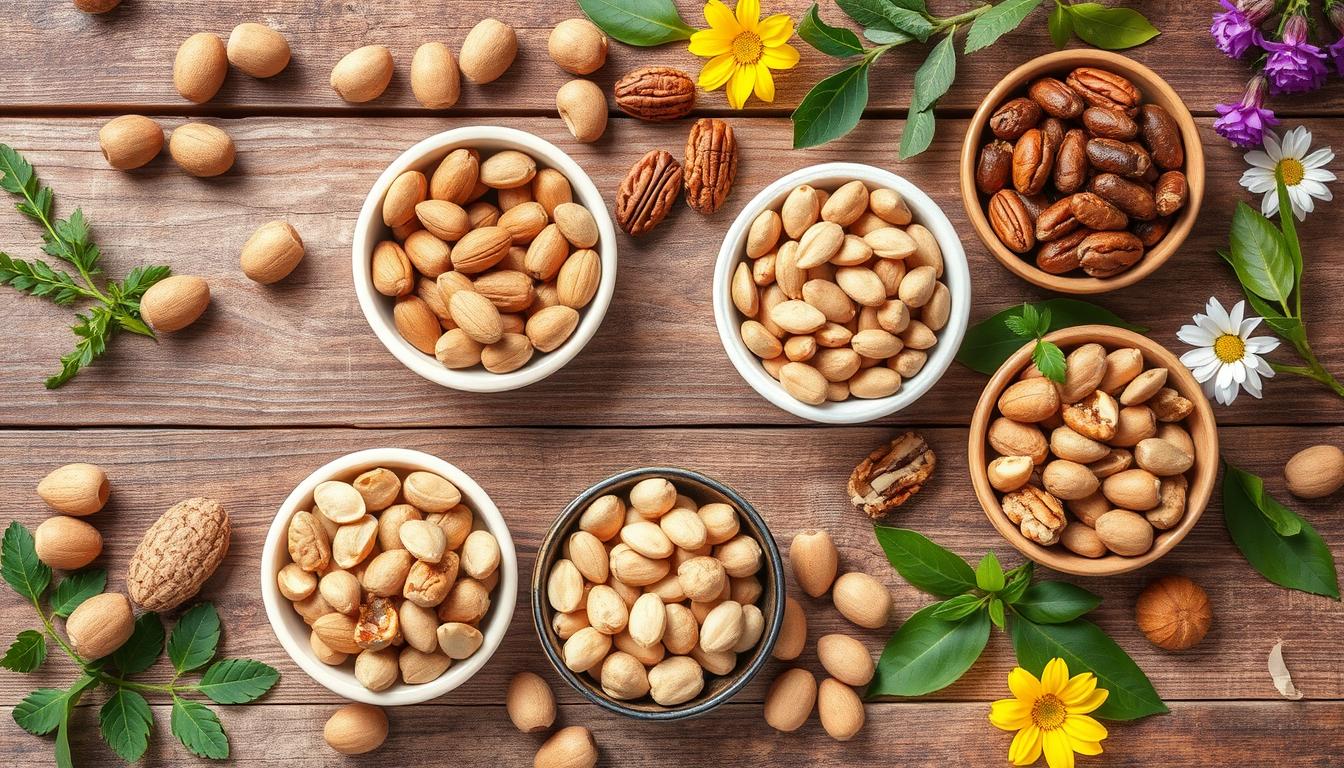Hazelnuts are key in cooking, but they can be tricky. Allergies are a big worry since hazelnuts are quite common allergens. Finding safe hazelnut substitutes is crucial.
Also, getting hazelnuts can be tough in some places. They’re pricier than many other nuts, so finding cheaper alternatives is a big help.
This guide is your top resource for hazelnut substitutes. It covers everything from how to measure them right to using them in different dishes. You’ll learn about both nut and non-nut options. Whether you’re baking or cooking, this guide will help you use hazelnuts in your recipes.
What are Hazelnuts?
Hazelnuts, also known as filberts, are oval nuts in a hard brown shell. They are loved for their sweet taste and nutritional value. Found in many places, they are mainly grown in Turkey, Italy, Spain, China, and the U.S.
These nuts are packed with health benefits. An ounce has about 175 calories, along with healthy fats, protein, and fiber. They are full of monounsaturated fats, which are good for the heart. They also have antioxidants that can help lower cholesterol.
Hazelnuts are great in many dishes, from desserts to savory meals. They go well with chocolate, berries, and citrus. Roasting them brings out their sweet taste, perfect for cakes, muffins, and pies. Hazelnut butter and oil are also popular for adding this unique flavor to food.
Hazelnuts have a rich history too. Native Americans used them to flavor soups. The American hazelnut can grow up to 3 meters tall and is valued for its beauty and practical uses.
| Hazelnut Characteristics | Description |
|---|---|
| Shape | Oval |
| Shell | Hard brown |
| Nutritional Value (per ounce) | 175 calories, healthy fats, protein, dietary fiber |
| Common Culinary Uses | Desserts, baking, savory dishes, hazelnut oil, hazelnut butter |
| Historical Use | Flavoring soups by Native Americans |
Why Substitute Hazelnuts?
There are many reasons to substitute hazelnuts. One big issue is hazelnut allergy, which can cause serious reactions. For those with allergies, finding safe alternatives is key.
Another problem is hazelnut availability. The supply can change due to where you live. Places like the Black Sea region and northern Turkey are big producers. But, things like labor costs and the environment can affect how much is available.
The hazelnut flavor intensity can be too strong for some dishes. This might make you want to use ingredients that don’t overpower the taste. Trying different substitutes can make your cooking more flexible and exciting. It lets you create dishes that really suit your taste.
Top Hazelnut Alternatives
Looking for the perfect substitute for hazelnuts can elevate your cooking. Many nuts can fill the gap, keeping your dishes tasty and textured. Let’s explore some top picks.
Almonds
Almonds are a great choice for hazelnut substitutes. They have a mild, nutty taste and a creamy texture. Use them in equal amounts for treats like biscotti, breads, and granola. Adding spices like cinnamon or nutmeg can boost the almond flavor.
Cashews
Cashews are sweet and creamy, making them perfect for sweet dishes. They’re great in cookies, pralines, and granola bars. Substitute them in equal amounts. Toasting them first can enhance their taste.
Walnuts
Walnuts offer a unique earthy flavor. They’re great in breads and muffins. Remember, their strong taste might need a bit less quantity. Use the same amount as hazelnuts for most recipes.
Pecans
Pecans are sweet and buttery, ideal for cakes and cookies. They’re a favorite for many baked goods. Substitute them 1:1, but you might need less sugar because of their sweetness.
| Nut | Flavor Profile | Texture | Substitution Ratio |
|---|---|---|---|
| Almonds | Mild, nutty | Creamy | 1:1 |
| Cashews | Sweet, nutty | Creamy | 1:1 |
| Walnuts | Earthy | Dense | Approx. 1:1, consider reducing |
| Pecans | Buttery, sweet | Rich | 1:1 (reduce sugar) |
Popular Non-Nut Substitutes
Looking to swap out hazelnuts in your recipes? There are many tasty non-nut options. These alternatives bring unique flavors and health perks to your dishes.
Sunflower Seeds
Sunflower seeds have a rich and nutty taste when toasted. They’re great for granola, veggie burgers, and bread. Use 1.5 times as many sunflower seeds as hazelnuts for the best flavor.
Grinding them makes your dish smoother. Sunflower seeds are also full of nutrients and antioxidants.
Pumpkin Seeds
Pumpkin seeds have a nutty taste with a spicy hint. They’re perfect for crusts and baked goods. Use 1.5 times as many pumpkin seeds as hazelnuts.
Toasting them boosts their flavor. They add crunch to salads and granola.
Flax Seeds
Flax seeds have a nutty taste and are rich in omega-3s. They’re great in granola bars and smoothies. Use double the amount of flax seeds as hazelnuts, but grind them first.
This makes them blend better. Spices like cinnamon can enhance their hazelnut-like taste. Flax seeds are good for digestion and heart health.

Flavorful Hazelnut-Based Products
Hazelnut-based products add a rich flavor and creamy texture to many recipes. They let you enjoy hazelnut flavor even when you can’t use whole nuts. Discover how these products can enhance your cooking and baking.
Hazelnut Oil
Hazelnut oil is known for its unique taste. It’s great for hazelnut oil flavor enhancement in dressings and baked goods. Use 1-2 teaspoons of oil for every 1/4 cup of hazelnuts for the best taste.
This oil makes vinaigrettes and sautéed dishes taste amazing. It adds a delicious nuttiness.
Hazelnut Butter
Hazelnut butter is a tasty substitute for hazelnuts in recipes. It has a creamy texture and strong flavor. You can use up to half the amount of hazelnuts with butter, adjusting fats as needed.
Try hazelnut butter recipes like spreads, smoothies, and baked goods. They will make your dishes even better.
Hazelnut Extract
Hazelnut extract is a quick way to add flavor without whole nuts. It’s a great hazelnut extract substitute for rich flavor. Use about 1/4 teaspoon of extract for every 1/4 cup of hazelnuts.
Adjust to taste in cookies, cakes, and custards. Its strong hazelnut extract flavor can make desserts taste like gourmet treats.
| Product | Primary Usage | Flavor Profile | Substitution Rate |
|---|---|---|---|
| Hazelnut Oil | Dressings, Baking | Rich, Nutty | 1-2 tsp per 1/4 cup |
| Hazelnut Butter | Spreads, Sauces | Creamy, Intense | Up to 50% |
| Hazelnut Extract | Baking, Flavoring | Concentrated Nutty | 1/4 tsp per 1/4 cup |
Substituting Hazelnuts in Different Dishes
When you’re cooking without hazelnuts, finding good replacements is easy. Each substitute has its own special qualities. This makes it easy to keep the taste and texture of your dishes just right.
For hazelnut substitutes in recipes like crusts, almonds are a great choice. They taste nutty and work perfectly in a 1:1 ratio. Walnuts are also great for baked goods like cookies. They add a strong flavor and a nice crunch.
Pecans are often overlooked but they’re a fantastic substitute. You can use them in the same amount as hazelnuts, adding a rich buttery taste to pies and baked treats. Macadamia nuts have a creamy texture and a buttery flavor. They’re perfect for baking and work in a 1:1 ratio.
Pistachios offer a sweet twist, making them great for cookies and brownies. Peanuts are a budget-friendly option. They have a slightly salty taste that works well in many desserts.
Cashews might not be the first choice for baking, but they’re mild and creamy. They’re great for desserts like cheesecakes. Using them in a 1:1 ratio adds richness to your dishes.

| Alternative Nut | Flavor Profile | Ratio for Substitution | Best Uses |
|---|---|---|---|
| Almonds | Nutty | 1:1 | Crusts, muffins |
| Walnuts | Rich and crunchy | 1:1 | Cookies, cakes |
| Pecans | Buttery | 1:1 | Pies, brownies |
| Macadamia Nuts | Butter-like | 1:1 | Cakes, cookies |
| Pistachios | Slightly sweet | 1:1 | Cookies, pastries |
| Peanuts | Salty | 1:1 | Cookies, cakes |
| Cashews | Mild and creamy | 1:1 | Desserts, smoothies |
Using hazelnut alternatives in cooking is a great way to get creative. Try out these substitutes to find the perfect match for your recipes. You’ll enjoy the unique flavors they add.
Substitute for Hazelnuts Guide
Having a reliable guide for cooking substitutes is key. This guide helps you find hazelnut replacements that keep your recipes tasty and textured. Explore a variety of nut and non-nut options to enhance your cooking.
A hazelnut replacement chart is a quick and useful tool. Below is a list of popular substitutes and how to use them:
| Substitute | Type | Notes |
|---|---|---|
| Almond Flour | Nut | Common in baked goods with approximately 600 calories per 100g. Provides 20g of protein and a mild flavor. |
| Hazelnut Flour | Nut | Higher in fat (643 calories per 100g) offers a richer flavor. Use as a direct 1:1 substitute for almond flour. |
| Sunflower Seeds | Non-Nut | A great nut-free alternative suitable for those with allergies. |
| Pumpkin Seeds | Non-Nut | Tasty substitution that provides a unique flavor, ideal for baking and snacks. |
| Cashew Nuts | Nut | Rich and creamy, perfect for making homemade spreads like Nutella. |
When looking at hazelnut alternatives, remember that not all have the same nutritional value. But, many share similar tastes and textures. You might need to tweak your cooking methods a bit. For example, hazelnut flour’s higher fat content can make it burn faster than almond flour.
This guide is a great starting point for exploring hazelnut substitutes. Whether you’re making a sweet treat or a savory dish, these options can help you get great results. Try these ingredients in your kitchen for tasty and exciting dishes!
Conclusion
Exploring hazelnut substitutes can really boost your cooking skills. It also meets dietary needs and finds what’s available. Almonds and cashews are great because they add crunch and taste to your food.
These alternatives can also make your dishes healthier by adding more protein. They taste similar to hazelnuts in many recipes.
When you cook without hazelnuts, try pecans, walnuts, and pumpkin seeds. They add a new flavor to savory dishes. For sweet dishes, cashews and almonds keep the creamy texture you love.
Thinking about hazelnut substitutes means being creative. Try hazelnut oil or butter for new tastes. With the right choices, your favorite dishes stay delicious, and you can enjoy every bite.
Source Links
- https://www.greedygourmet.com/hazelnut-substitutes/
- https://www.chefspencil.com/crunchy-goodness-try-these-hazelnut-substitutes-in-your-recipes/
- https://lowhistamineeats.com/substitute-for-hazelnuts/
- https://plants.usda.gov/DocumentLibrary/plantguide/pdf/pg_coam3.pdf
- https://discover.texasrealfood.com/swap-and-savor/hazelnuts-substitutes
- https://ayoubs.ca/blogs/news/everything-you-need-to-know-about-hazelnuts?srsltid=AfmBOorErmvn-_0K14fRw4aLrRjXAy0hspeuEB5C-Lx4obnp9LBKk7sv
- https://permies.com/t/69019/Amazing-Hazel-Essential-Guide-Hazels
- https://www.epicurious.com/expert-advice/healthy-nutella-alternatives-article
- https://www.eater.com/24249002/how-to-use-hazelnuts-dukka-pie-crust-semifreddo
- https://www.thespruceeats.com/baked-goods-nut-substitutes-1388892
- https://emsnutfreeeats.com/nut-free-chocolate-spread-guide/
- https://theveganatlas.com/a-guide-to-hazelnuts-with-tips-recipes/
- https://casadesante.com/blogs/flour-guide/hazelnut-flour-vs-coconut-flour?srsltid=AfmBOooSQAJpgf8SJ_rbadI0shoS9rQVkZgfX27TEc5R9i0ZHivje91J
- https://bakeschool.com/nutella-with-any-other-nut-is-just-as-delicious/
- https://cookscrafter.com/hazelnuts-substitutes/
- https://extension.oregonstate.edu/catalog/pub/em-9081-growing-hazelnuts-pacific-northwest-integrated-pest-management
- https://zestforbaking.com/hazelnut-flour-vs-almond-flour
- https://discover.texasrealfood.com/swap-and-savor/how-to-substitute-hazelnuts-for-almonds
- https://casadesante.com/blogs/flour-guide/all-purpose-flour-vs-hazelnut-flour?srsltid=AfmBOopn9vLeewyn_XgFqPS8ISRQFlT3ybmrIbn8LfhSav1P8GhcGcXr
